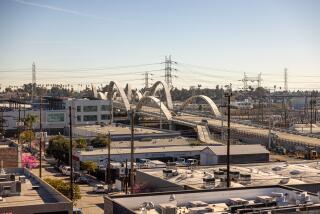Ground Down by High-Rise Fever
- Share via
ANN ARBOR, Mich. — Since moving many years ago to the downtown neighborhood of this college community, I have watched an ever-fragile Main Street shopping area gradually wilt under the hammering competition of malls and cut-rate department stores at the city’s outskirts. Now the City Council has warmly embraced a proposal that would bring more foot traffic to downtown by erecting high-rise, multi-use buildings a block west of the modest one- and two-story shops.
If this is good news, as the downtown merchants and developers and planning commissioners think, why do I feel so melancholy?
The short and selfish answer is that these structures will act as a physical barrier between downtown and the neighborhoods that have loyally nourished it. The longer answer involves the high-rise concept itself, and the misgivings that I share with many others about the way a long-standing infatuation with tall buildings has alienated us from our cities.
The architect Mies van der Rohe warned us, when he helped to popularize the glass-walled buildings that now dominate our environment, that cities have become impersonal because the individual has lost significance in Western culture. Such buildings are designed to measure down our inflated private egos, as Stonehenge must have reminded the Celt what a diminished thing he or she was, and as Gothic cathedrals similarly functioned for anyone vain enough to enter them in a mood of self-importance. The high-rise points away from ordinary satisfactions; it speaks to us, imperiously, of institutional power and goals compared to which our individual desires and achievements are trivial.
When did the euphoria about tall buildings evaporate? In earlier decades of this century the skyscraper was a national symbol of triumphant American technology and cosmopolitan splendor. Especially in Manhattan, the Empire State and Chrysler buildings, and later the Seagram tower, stirred utopian dreams of a prosperous, purposeful society spiritually fulfilling to each of its members, all directed by the intelligences at work in those lofty offices. Georgia O’Keefe and Charles Sheeler painted skyscrapers in radiant tones, as if they grew upside-down from heaven, concrete and steel expressions of God’s will.
Since the 1960s, however, the proliferation of monolithic slabs and rounded towers, and scalloped or sculpted versions of the same basic design, has created an increasingly claustrophobic effect. The healthy eye needs a horizon, Emerson said. The glass curtain-walls of these buildings block the vision and weigh on the imagination of city-dwellers. It isn’t surprising that so many science-fiction writers look with foreboding into a future of anthill-like city-states where billions of people are crammed into colossal warrens.
Because high-rise strutcures are essential to the efficient functioning of modern society, they will continue to be built, in one style or another. Nobody doubts their usefulness, or their necessity. And a moment’s thought tells us that, as with every other artifact of modern technology, we will conform to what we live with or inside of, whether we like it at first or not. Already we are numb to the forbidding exteriors, the sterile interiors, the labyrinthine parking structures.
For each of us there is a memory of some human-scale neighborhood that grew heartlessly higher and higher as friendly stores and homes yielded to the looming ramparts of corporate America. For me, the present-day Ann Arbor is about to become such a memory, and its rising skyline overshadows more than nearby houses. Isn’t there some way to make a sense of regret inform public policy, at least a little? To use against his legacy the observation of Mies van der Rohe that less is more?
More to Read
Sign up for Essential California
The most important California stories and recommendations in your inbox every morning.
You may occasionally receive promotional content from the Los Angeles Times.






